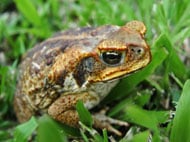Description:
The cane toad is simply kept in captivity, when provided with a few basic requirements. A large plastic bin will work as an enclosure, but the lid must be modified to allow for ventilation. Then use 100 percent silicone aquarium sealant to attach aluminum screening to a large portion of the top of the lid. Of course, a large aquarium or terrarium (minimum 35 gallon will work as well, but this will be more expensive). Damp paper towels provide a suitable substrate, but these require frequent changing because these animals eat a lot, and in turn produce a lot of waste. Two to 4 inches of peat moss or coco coir will also work well as a substrate. The substrate should be changed at least every other week to ensure the animal lives in a clean environment. A large water bowl will also be necessary to be sure these animals maintain adequate hydration. If they are not kept clean, these animals often develop severe bacterial infections. Temperatures in the mid to upper 70s degree Fahrenheit are suitable for this species. Higher temperatures should be avoided, as they will stress the animal. Cane toads eat a wide variety of foods under captive conditions. As with many amphibian species, a diet consisting mainly of crickets will work well with this species. Supplementing crickets with king mealworms, earthworms, large silk moth larvae and captive-reared tomato hornworm larvae will ensure the cane toad will maintain proper body weight. The diet can occasionally be supplemented with a fuzzy mouse, but mice will contribute to obesity if they are fed too often. If you are going to keep these animals, take care to be sure they are not allowed to escape, and never release these animals into the wild. The countries to which they have been introduced have made many unsuccessful attempts to eradicate them.
Habitat:
Cane toads inhabit both tropical and semi-arid environments.
Range:
Cane toads are native to the extreme southern United States, Central and South America. They have been carelessly introduced in many regions, including islands of the Pacific and Caribbean, and most notoriously in Australia. The idea behind these introductions was to use these animals in pest control. Their extreme spawn rate and toxic skin secretions have allowed these animals to out-compete many of the native anurans in areas where they were introduced.
Scientific Name: Bufo marinus
Species Group: toad
Family: Bufonidae
Size: Adults usually measure up to 8 inches in total length.
Level: intermediate
Weight: N/A
Dangerous: No


